Leaf is the main food-making part of almost all plants. Garden flowers, grasses, shrubs, and trees depend on their leaves to make food for the rest of the plant. So do many other plants, including ferns, vegetables, vines, and weeds.

Each leaf is a little food factory. It captures energy from sunlight and uses it to make sugar out of water from the soil and carbon dioxide, a gas in the air. This sugar is changed to many other chemical substances. These substances become the food that provides plants with energy to grow, to produce flowers and seeds, and to carry on all their other activities. Plants store the food made by leaves in their fruits, roots, seeds, stems, and even in the leaves themselves. Without this food, plants could not live. In addition, all the food that people and animals eat comes either from plants or from animals that eat plants.
Leaves vary in appearance among plants. Many are oval, but others are shaped like arrowheads, feathers, hands, hearts, or any number of other objects. However, most leaves can be divided into three groups according to their basic shape. (1) Broad leaves are the type of leaf that most plants have. These leaves are fairly wide and flat. Plants that have such leaves include maple and oak trees, pea plants, and rosebushes. (2) Narrow leaves are long and slender. Narrow leaves grow on grasses. Grasses include not only lawn grasses but also barley, corn, oats, wheat, and other cereal grasses. Lilies, onions, and certain other plants also have narrow leaves. (3) Needle leaves grow on firs, pines, spruces, and most other cone-bearing trees and shrubs. Needle leaves resemble short, thick sewing needles. A few other kinds of cone-bearing plants, including certain cedars and junipers, have scalelike leaves.

Most leaves grow from 1 to 12 inches (2.5 to 30 centimeters) in length. Some plants, however, have huge leaves. The largest leaves grow on the African raffia palm. The leaves of this tree measure up to 65 feet (20 meters) long. The giant water lily of South America has round, floating leaves that grow up to 6 feet (1.8 meters) across. In contrast, some plants have extremely small leaves. The true leaves of asparagus plants, for example, are so tiny that they are hard to see without a magnifying glass. In these plants, the stems, rather than the leaves, produce food.
The number of leaves on plants ranges from several to thousands. Most soft-stemmed plants have few leaves. For instance, a barley or wheat plant produces only 8 to 10 leaves each season. But trees and shrubs have an enormous number of leaves. A fully grown elm or pine tree produces thousands of leaves.
Some simple plants that manufacture their own food do not have leaves. For example, liverworts and mosses are simple food-making plants that lack true leaves. In some of these simple plants, however, the green food-making tissues look like tiny leaves.
The importance of leaves
The chief job of leaves is to make food for plants. This food-making activity, called photosynthesis, occurs mostly in fully grown leaves. But young leaves also are important. They wrap tightly around the tips of growing stems. They thus keep the delicate tips moist and help protect them from insects, cold, and other dangers.
Leaves are also vital to animals. Animals cannot make their own food. They depend on plants for their basic supply of food. Many animals eat leaves. For example, antelope, sheep, and other grazing animals eat grass leaves. People also eat leaves, such as those of cabbage, lettuce, and spinach plants. But even when people and animals eat the fruits, roots, seeds, and stems of plants, they are obtaining food made by leaves. In the same way, eggs, meat, milk, and all other animal foods can be traced back to food made by photosynthesis.
Leaves help make the air breathable. They release oxygen during photosynthesis. People and animals must have oxygen to live. Without the activities of leaves, the earth’s supply of breathable oxygen would probably soon be used up.
People obtain many products from leaves in addition to food. For instance, we use the leaves of the tea plant to make tea. Peppermint and spearmint leaves contain oils used to flavor candy and chewing gum. Such leaves as bay, sage, and thyme are used in cooking to flavor foods. Some drugs come from leaves. For example, the drug digitalis, which is used to treat certain heart diseases, comes from the leaves of the purple foxglove, a common garden flower. Leaves of abaca and sisalana plants provide fiber used in making rope. Finally, the leaves of the tobacco plant are used to make cigarettes, cigars, and other tobacco products.
The life story of a leaf
A leaf begins its life
in a bud. Buds are the growing areas of a stem. They form along the sides of the stem, at the point just above where a fully grown leaf is attached. A bud also grows at the tip of the stem. A leaf bud contains undeveloped leaf and stem tissues. Within the bud is a mound slightly larger than the head of a pin. Each leaf starts out as a tiny bump on the side of this mound. The mature bud contains a tightly packed group of tiny leaves.
In most soft-stemmed plants, the buds are hard to see. A new leaf becomes noticeable only after it begins to unfold. Most soft-stemmed plants continue to form new leaves until the plants flower or until cold weather sets in. In temperate regions, which have warm summers and cold winters, the aboveground parts of many soft-stemmed plants die after the first hard frost, but the roots live through the winter. Other soft-stemmed plants die completely after the cold weather arrives.
Woody plants, on the other hand, may live many years. They grow several sets of leaves during their lifetime. Most needleleaf trees and shrubs shed old leaves and grow new ones continuously throughout the year. So do most broadleaf trees in the tropics. But in temperate regions, most broadleaf trees and shrubs are deciduous. Deciduous plants of temperate regions shed all their leaves each fall and grow a new set each spring.
Deciduous trees and shrubs start growing the next year’s leaves even before the present year’s leaves have fallen. The new leaves are enclosed in winter buds. The leaves in the winter buds stop growing during the summer and remain dormant (inactive) throughout the winter. During the winter months, the buds are protected from drying out by special outer leaves called bud scales. In spring, warmth and moisture cause the dormant leaves to become active. The bud scales drop off, and the leaves unfold.
The leaf becomes fully grown.
Leaves complete their growth within one week to several weeks, depending on the kinds of plants that produce them. At first, the unfolding leaf must get all its food from older leaves or from food stored by the plant. Soon, however, the young leaf turns a deeper green and begins to make its own food. Gradually, the leaf produces extra food, which is sent to the rest of the plant.
During the growing season, the color of the leaf changes from bright green to a duller green. The leaf also becomes tougher because its cells develop thicker walls. During this time, a special change occurs in the leaves of deciduous trees and shrubs. A corky layer of cells known as the abscission zone develops where the stalk of the leaf joins the stem. This zone breaks down in autumn, causing the leaf to separate from the stem.
The leaf changes color.
The leaf is green because it contains a green pigment (coloring matter) called chlorophyll. This pigment plays a major role in photosynthesis. The leaf also has other colors, but they are hidden by the chlorophyll. As autumn approaches, however, the shorter days and cooler nights cause the chlorophyll in deciduous broad leaves to break down.
The hidden colors of the leaf appear as the chlorophyll breaks down. The leaf may then show the yellow color of the pigment xanthophyll or the orange-red tones of the carotene pigments. In addition, a group of red and purple pigments called anthocyanins forms in the dying leaf. The color of the autumn leaf depends on which of the pigments is most plentiful in the leaf.
The leaf dies.
After the chlorophyll breaks down, the leaf can no longer make food. The tiny pipelines between the leaf and the stem become plugged. These pipelines carried water to the leaf and food from it. The cells in the abscission zone separate or dissolve, and the dying leaf hangs from the stem by only a few strands. These strands dry and twist in the wind. When the strands break, the dead leaf floats to the ground.
After the leaf falls, a mark remains on the twig where the leafstalk had been attached. This mark is called a leaf scar. The broken ends of the water and food pipelines can be seen within the leaf scar.
On the ground, the dead leaf becomes food for bacteria and fungi. They break the leaf down into simple substances, which then sink into the soil. There, these substances will be absorbed by plant roots and provide nourishment for new plant growth.
The parts of a leaf
Most leaves have two main parts: (1) the blade and (2) the petiole, or leafstalk. The leaves of some kinds of plants also have a third part, called the stipules.
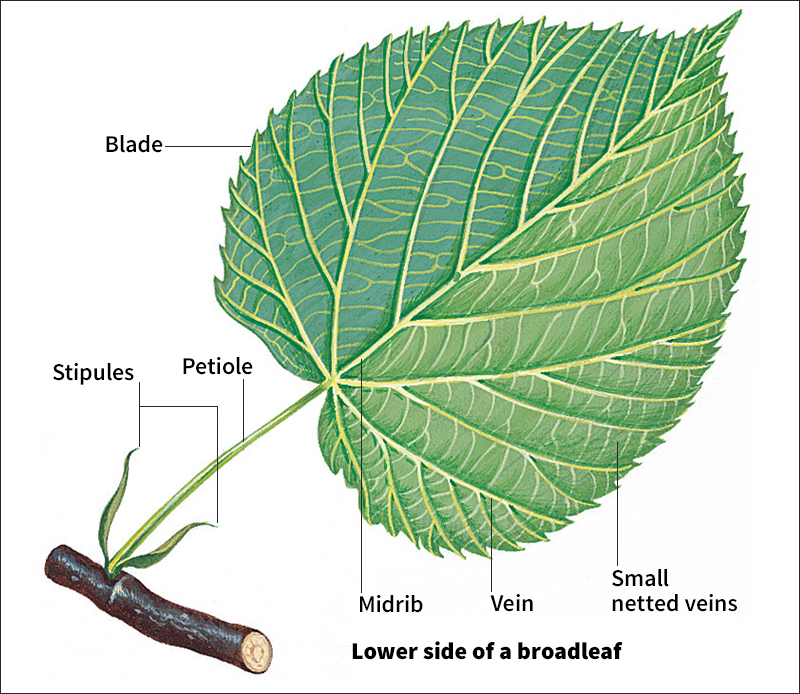
The blade,
or lamina, is the broad, flat part of the leaf. Photosynthesis occurs in the blade, which has many green food-making cells. Leaf blades differ from one another in several ways. The chief differences are in: (1) the types of edges, (2) the patterns of the veins, and (3) the number of blades per leaf.
The types of edges.
Almost all narrow, grasslike leaves and needle leaves have a blade with a smooth edge. But the edge of broadleaf blades varies greatly among the different types of plants.

Many broadleaf plants, particularly those that are native to warm climates, have smooth-edged leaf blades. The rubber plant, a common house plant, is a good example of such a plant.
The leaves of many temperate broadleaf plants have small, jagged points called teeth along the blade edge. Birch and elm trees have such leaves. In many plants, the teeth contain hydathodes, tiny valvelike structures that can release excess water from the leaf. The teeth of young leaves on many plants, including cottonwood and pin cherry trees, bear tiny glands. These glands produce liquids that protect the leaf from plant-eating insects.
Some temperate broadleaf plants—including sassafras trees and certain mulberry and oak trees—have lobed leaves. The edge of such a leaf looks as if large bites have been taken out of it. The lobing helps heat escape from the leaf.
The patterns of the veins.
Veins are pipelines that carry food and water in a leaf. If you hold a leaf blade up to light, you can see the pattern of its veins.

In most broad leaves, the veins form a netlike pattern, with several large veins connected by many smaller ones. The smallest veins supply every part of the blade with water. They also collect the food made by the green cells.
There are two main types of net-vein patterns—pinnate (featherlike) and palmate (palmlike or handlike). Pinnately net-veined leaves have one large central vein, called the midrib, which extends from the base of the blade to its tip. Other large veins branch off on each side of the midrib. The leaves of beech, birch, and elm trees have such a vein pattern. A palmately net-veined leaf has several main veins of about equal size, all of which extend from a common point at the base of the blade. The vein patterns of maple, sweet gum, and sycamore leaves are palmate.
Narrow leaves and needle leaves are not net-veined. Narrow leaves have a parallel-vein pattern. Several large veins run alongside one another from the base of the blade to the tip. Small crossveins connect the large veins like steps on a ladder. Needle leaves are so small that they have only one or two veins. These veins run through the center of the blade.
Leaf veins do more than carry water and food. They also support the blade, much as the metal ribs support the fabric of an open umbrella. The veins are tougher and stronger than the green tissue around them. They help the leaf keep its shape and prevent it from collapsing or tearing.
The number of blades per leaf.
A leaf may have one or more blades. A leaf that has only one blade is called a simple leaf. Apple and oak trees, grasses, and many other kinds of plants have simple leaves. A leaf that has more than one blade is known as a compound leaf. The blades of a compound leaf are called leaflets.

The leaflets in a compound leaf may be arranged in a pinnate or palmate pattern. In pinnately compound leaves, the leaflets grow in two rows, one on each side of a central stalk, called the rachis. Plants with pinnately compound leaves include ash and walnut trees and garden peas. The leaflets in a palmately compound leaf are attached at the tip of the leafstalk. Clover, horsechestnut trees, and many other plants have palmately compound leaves.
A few plants—including carrots, honey locust trees, and Kentucky coffeetrees—have double compound leaves. In double compound leaves, each leaflet is divided into a number of still smaller leaflets. One double compound leaf looks more like a group of twigs and leaves than like a single leaf.
The petiole
is the stemlike part of the leaf. It joins the blade to the stem. Within a petiole are tiny tubes, bound together tightly like a bundle of drinking straws. These tubes are a continuation of the midrib veins. Some of the tubes carry water into the leaf. Others carry away food that the leaf has made.
The leaves of many plants have petioles that grow extra long if the blades are shaded. For example, white clover plants growing among unmowed grass may have petioles up to 6 inches (15 centimeters) long. These long petioles lift the clover leaflets into the sunlight. In a lawn where the grass is kept short, the clover petioles may measure less than 1 inch (2.5 centimeters) long.
In many trees and shrubs, the petioles bend in such a way that the blades are turned to receive the most sunlight. As a result of this bending, few of the leaves are shaded by other leaves. The petiole also provides a flexible “handle” that enables the blade to twist in the wind and so avoid damage.
In some plants, the petioles are much larger than the stems to which they are attached. For example, the parts we eat of celery and rhubarb plants are petioles. In contrast, the leaves of some soft-stemmed plants, particularly grasses, have no petioles.
The stipules
are two small flaps that grow at the base of the petiole of some plants. Many stipules look like tiny green leaf blades. In some plants, the stipules grow quickly, enclosing and protecting the young blade as it develops. Some stipules, such as those of willows and certain cherry trees, produce substances that prevent insects from attacking the developing leaf.
In many plants, the stipules drop off after the blade has developed. But garden peas and a few other kinds of plants have large stipules that persist and become an extra food-producing part of the leaf.
How a leaf makes food
A green leaf is a marvelous food-making factory. Using only the energy of the sun, it takes simple materials and turns them into energy-rich food. This section describes how a leaf obtains the raw materials needed to make food. It then provides a simple explanation of how the leaf produces food through photosynthesis. Finally, this section discusses transpiration, a process of water loss that plays a key role in the operation of the leaf food factory.
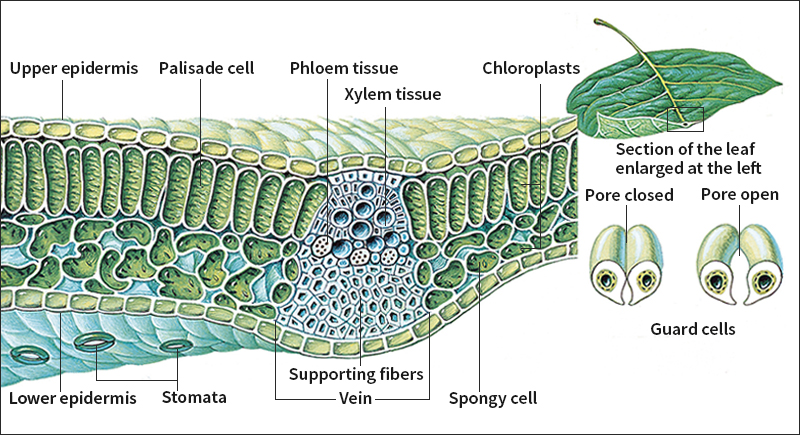
Obtaining the raw materials.
A leaf needs three things to make food. They are (1) carbon dioxide, (2) water, and (3) light. The carbon dioxide and water serve as the raw materials of photosynthesis. The light, which is normally sunlight, provides the energy that powers photosynthesis.
Carbon dioxide
enters a leaf from the air. The epidermis (outer surface) of the leaf has many tiny pores. These openings, called stomata, enable carbon dioxide to enter the leaf. Each pore is surrounded by two curved, bean-shaped guard cells that can swell and relax. When they swell, the pore is opened wide, and carbon dioxide enters the leaf. When the guard cells relax, the pore closes. In most plants, the stomata open during the day and close at night.
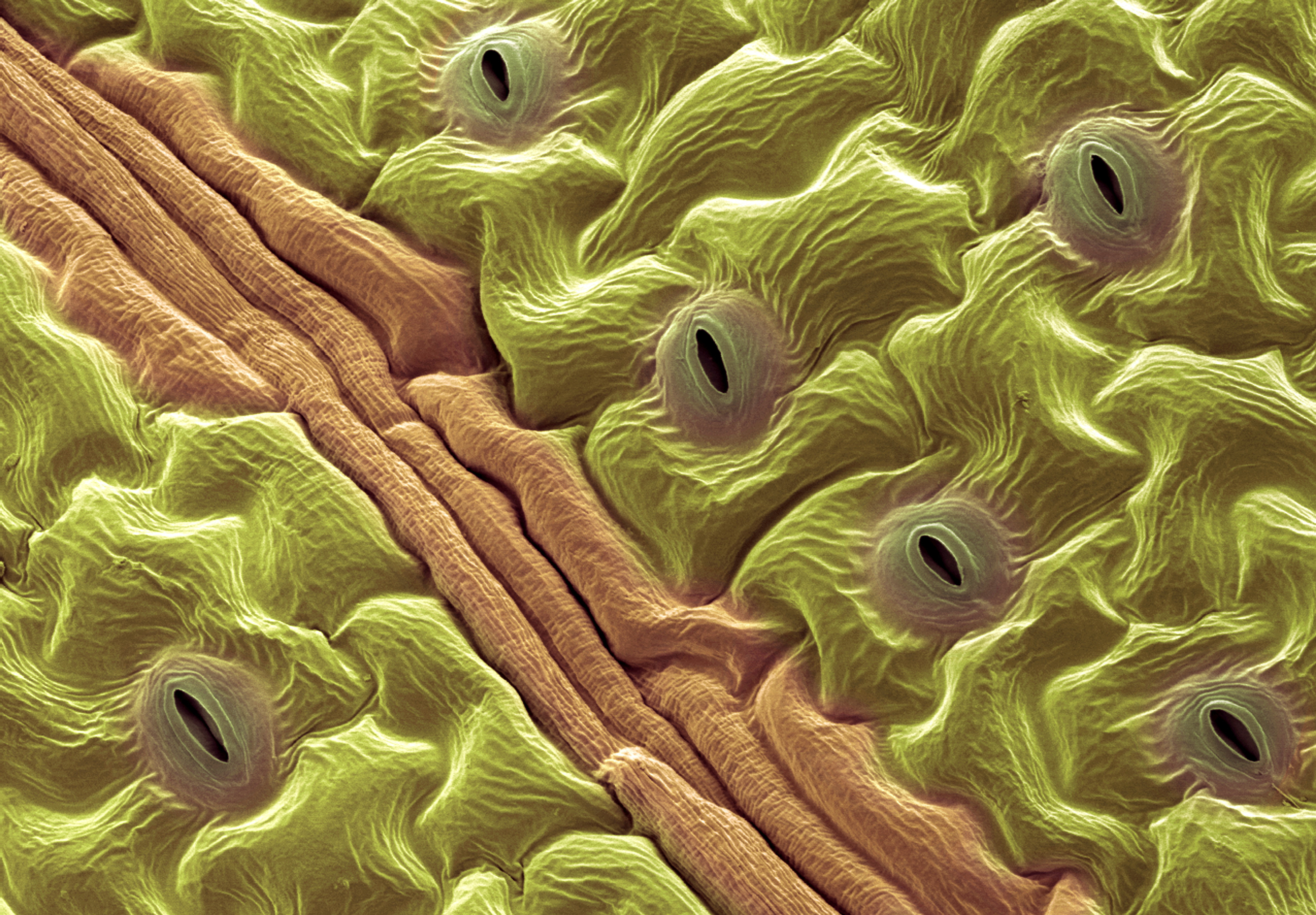
A leaf has many stomata. For example, a cottonwood leaf may have 1 million stomata, and a sunflower leaf nearly 2 million. However, the pores are so small that they make up less than 1 percent of the leaf’s surface. In most plants that grow in full sun, the majority of the stomata are in the shaded lower epidermis of the leaves. In many other plants, the stomata are about equally divided between the upper and lower epidermis.
Water.
A leaf obtains water that has been absorbed by the plant’s roots. This water travels up the stem and enters the leaf through the petiole. Tiny tubes in the leaf’s veins carry the water throughout the blade. These tubes make up the vein’s xylem (water-transporting tissue).
The inside of the blade is very humid. The epidermis is covered by a waxy coating called the cuticle, which helps keep the leaf from drying out. Nevertheless, a leaf does lose much water. Most of it escapes as vapor through the stomata by the process of transpiration.
Light.
Leaves cannot make food without light. But most leaves work best when the sunlight is at a certain level of brightness. If the light is too dim, the leaf will not make enough food. But if the light is too bright, it can damage the food-making cells.
The leaves of many plants that grow in bright sunlight have an extremely thick cuticle, which helps filter out strong light and guards against excess water loss. The leaves may also have many threadlike structures called hairs growing out of the epidermis. These structures are not true hairs, which grow only on mammals, but they resemble hairs. Epidermal hairs further reduce the intensity of bright light. Such plants as geraniums and white poplar trees have so many epidermal hairs that they feel fuzzy.
Some plants, including the herbs, ferns, and shrubs of the forest floor, thrive in shade. The leaves of most of these plants have a thin cuticle and few epidermal hairs. These features allow as much of the dim light as possible to enter the leaves.
Photosynthesis
occurs inside the leaf blade in two kinds of food-making tissues—palisade tissue and spongy tissue. The tall, slender cells of the palisade tissue are the chief food producers. They form one to three layers beneath the upper epidermis. The broad, irregularly shaped cells of the spongy tissue lie between the palisade tissue and the lower epidermis. Floating within both kinds of cells are numerous small green bodies known as chloroplasts. Each chloroplast contains many molecules of the green pigment chlorophyll.
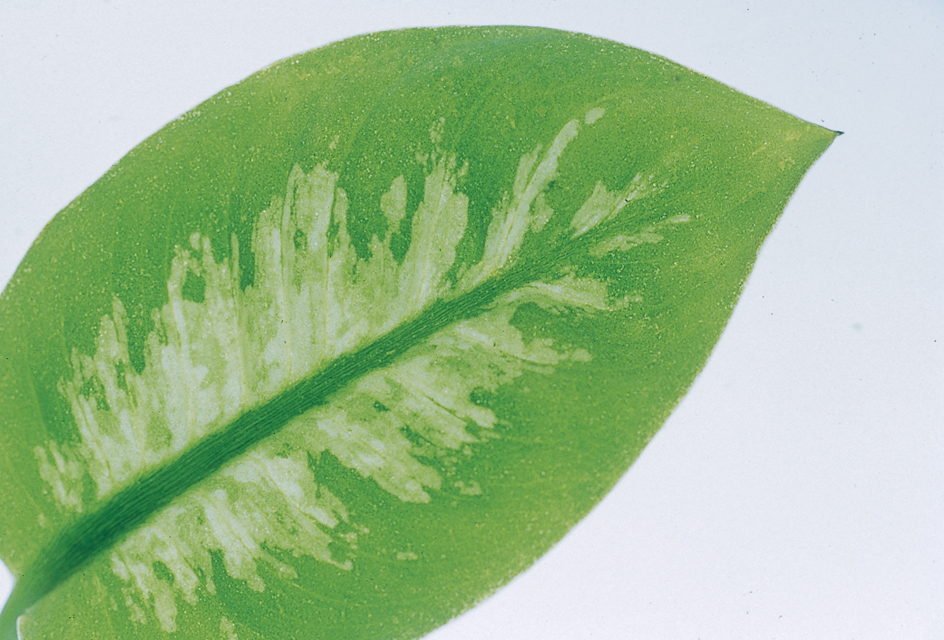
Partly surrounding each cell of the palisade and spongy tissue is an air space filled with carbon dioxide, water vapor, and other gases. The cells absorb carbon dioxide from this air space. When light strikes the chloroplasts, photosynthesis begins. The chlorophyll absorbs energy from the light. This energy splits the water molecules into molecules of hydrogen and oxygen. The hydrogen then combines with carbon dioxide to produce a simple sugar. This process is extremely complicated and involves many steps. The oxygen that is left over from the splitting of the water molecules enters the air through the stomata.
The sugar produced by photosynthesis is carried in special tubelike cells that make up the vein’s phloem (food-transporting tissue). The sugar moves through the petiole to the stem and all other parts of the plant. In the plant cells, the sugar may be burned and thus release energy for growth or other activities. Or the sugar may be chemically altered and form fats and starches. In addition, the sugar may be combined with various minerals, and so produce proteins, vitamins, and other vital substances. The minerals enter the plant dissolved in the water absorbed by the roots.
Transpiration
occurs as the sun warms the water inside the blade. The warming changes much of the water into water vapor. This gas can then escape through the stomata. Transpiration helps cool the inside of the leaf because the escaping vapor has absorbed heat.
Transpiration also helps to keep water flowing up from the roots. Water forms a continuous column as it flows through the roots, up the stem, and into the leaves. The molecules of water in this column stick to one another. As the molecules at the top of the column are lost through transpiration, the entire column of water is pulled upward. This pulling force is strong enough to draw water to the tops of the tallest trees. In addition, transpiration ensures a steady supply of dissolved minerals from the soil.
A plant may lose much water through transpiration. A corn plant, for example, loses about 4 quarts (3.8 liters) of water on a hot day. If the roots cannot replace this water, the leaves wilt and photosynthesis stops.
Specialized leaves
Some leaves have special functions along with or instead of food making. Such specialized leaves include (1) protective leaves, (2) storage leaves, (3) tendrils, (4) bracts, and (5) insect-capturing leaves.
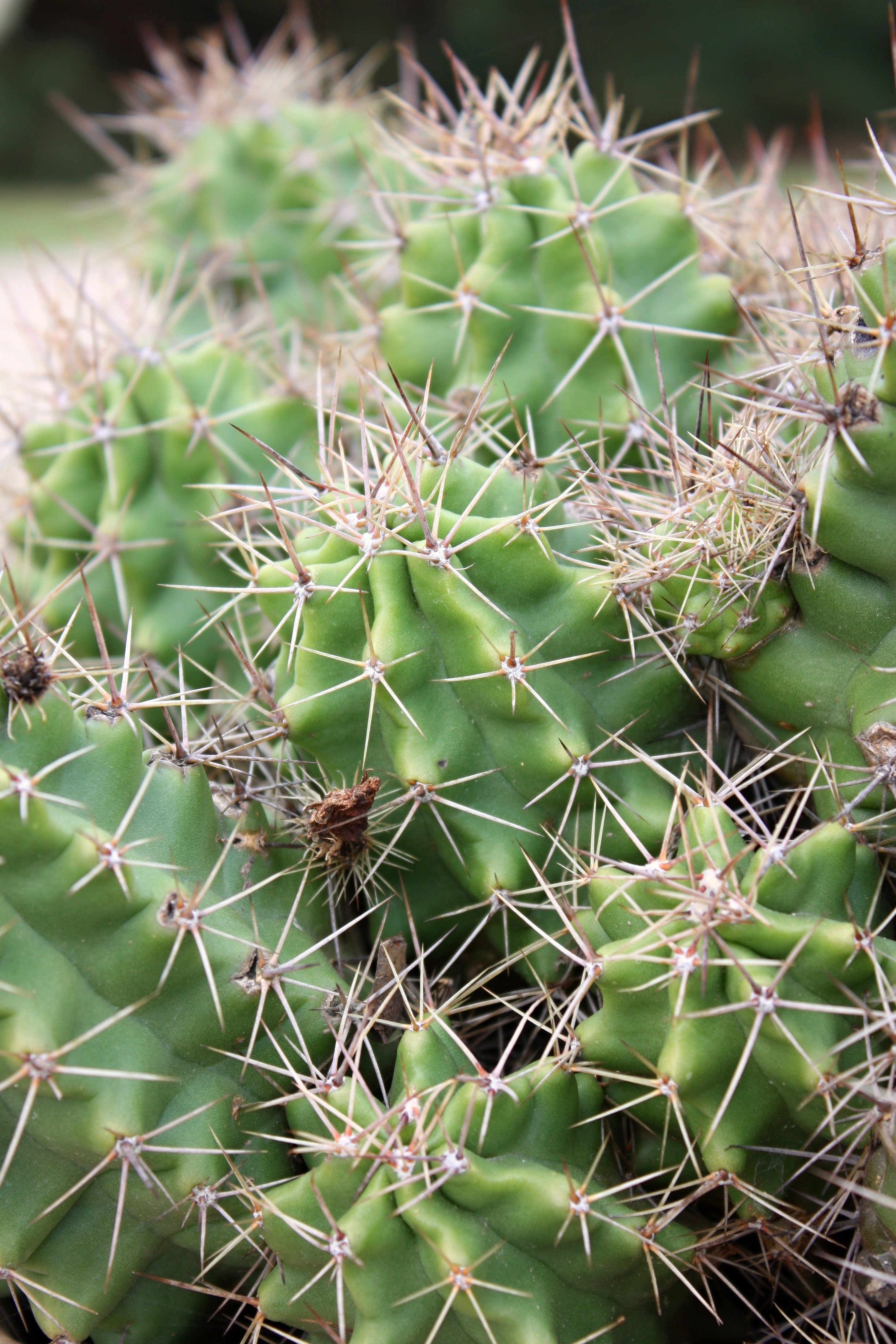
Protective leaves
include bud scales, prickles, and spines. As described earlier, bud scales are specialized leaves that protect the young, undeveloped tissues of the bud. Bud scales are short and broad, and they overlap like roof shingles. In many plants, the bud scales have an outer layer of waterproof cells.
Prickles and spines are sharp leaf structures that protect the plant from being eaten. For instance, prickles cover the leaves of the Canada thistle. The prickles protect the plant from grazing animals. Many cactuses have clusters of spines. In many species of cactuses, the pointed spines replace the leaves on the mature plants. In these plants, the green stem has the job of photosynthesis.
Storage leaves.
Most plants store food in their roots or stems. However, some plants have special leaves that hold extra food. Onion and tulip bulbs, for example, consist mainly of short, fat storage leaves called bulb scales. These leaves cannot make food. Their job is to store food underground during the winter months. See Bulb.
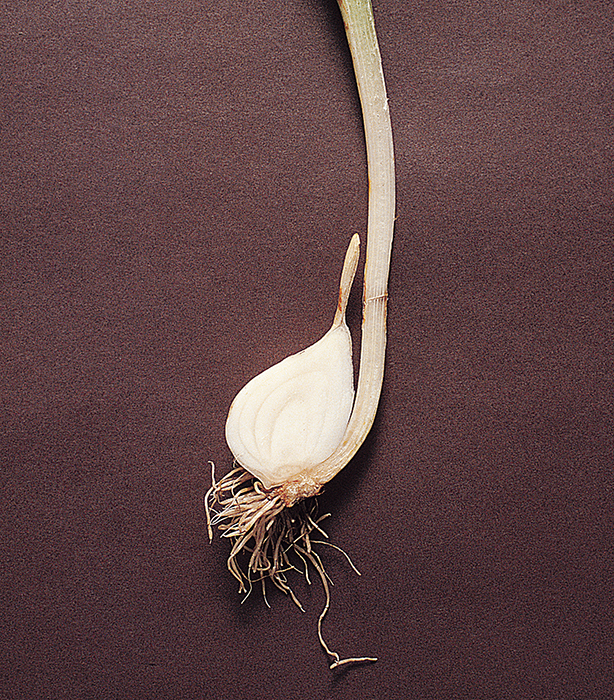
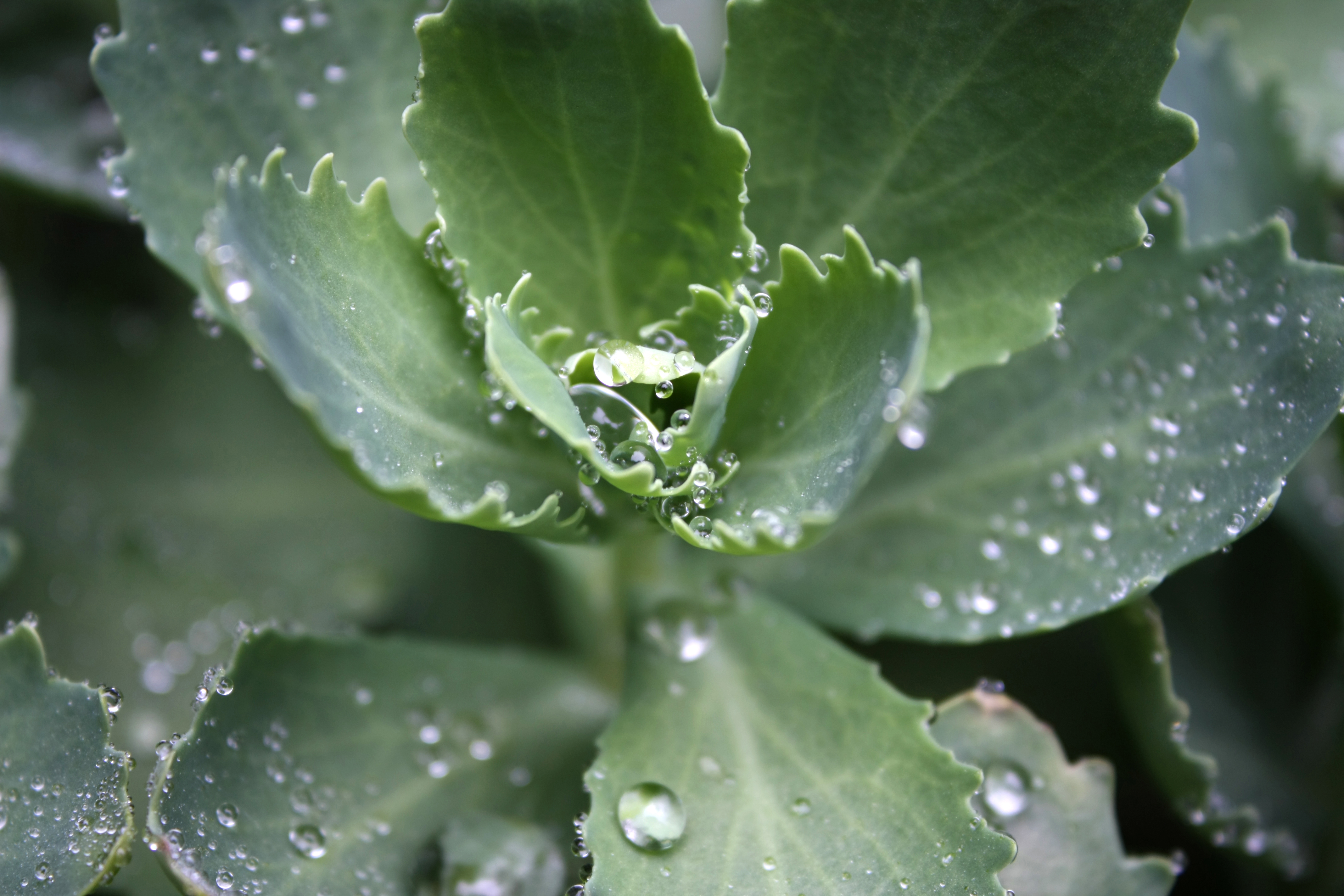
Many plants that grow in dry places have thick leaves that store water. The mosslike stonecrop plants that grow on rocky cliffs in the Southwestern United States have such leaves.
Tendrils
are slender, whiplike structures that help hold climbing plants in place. They wrap around twigs, wires, and other solid objects.
Among many climbing plants, specialized leaves serve as tendrils. For example, climbing garden peas have compound leaves in which the upper leaflets are threadlike tendrils. In one kind of sweet pea, a garden flower, the entire leaf blade becomes a tendril. The plant’s stipules enlarge and take over the food-making job. In the greenbrier vine, the stipules form long, curving tendrils.
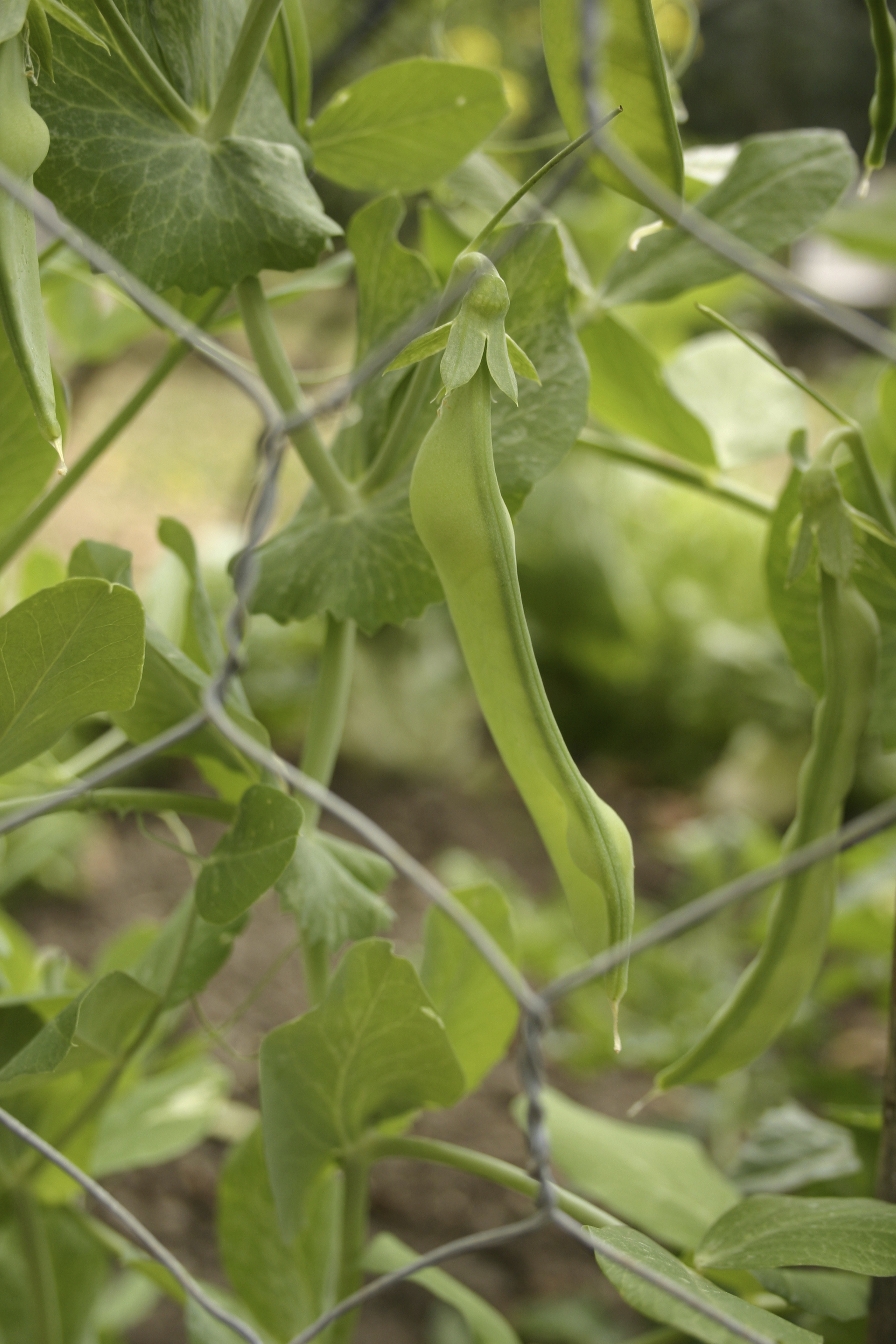
Bracts
grow just below the blossoms of certain plants. Most bracts are smaller and simpler in shape than a plant’s regular leaves. Many members of the daisy family—including daisies, goldenrods, marigolds, and sunflowers—have bracts. These bracts form a cup beneath the plant’s cluster of flowers.
A few kinds of plants, such as the flowering dogwood and poinsettia, have large, showy bracts. These bracts look like part of the flower, but they are not.
Insect-capturing leaves.
Carnivorous (meat-eating) plants, such as the butterwort, pitcher plant, sundew, and Venus flytrap, have leaves that capture insects. These leaves, like other leaves, can make food using sunlight. But they also have features that attract, trap, and then digest insects. Plants with insect-capturing leaves grow in wetlands, where the soil contains little nitrogen. They obtain this necessary nutrient from the captured insects. For a description of these plants and their leaves, see the article Carnivorous plant.
How to collect leaves
Collecting leaves or leaf rubbings and prints can be an enjoyable hobby. You can find plants with interesting leaves in fields, forests, and gardens and even along city streets. But before you remove any leaves from a plant, be sure to obtain permission from the owner of the land. In many parks and other public lands, it is illegal to take leaves.
When you collect large leaves, remove only a few. Always pick a complete leaf, including the petiole. In most leaves, the petiole will separate easily from the stem. If you are collecting compound leaves, remember to keep all the leaflets attached to the long petiole. When you collect small leaves, you may need to cut off part of a twig. Keep the leaves attached to the twig, and treat the cutting as if it were a single leaf. Always collect the small needle leaves of firs, pines, and spruces this way.
How to preserve leaves.
Freshly cut leaves will curl and crack unless you press them. To press leaves, arrange them between several sheets of newspaper. Then place a weight on the newspapers. A piece of plywood with books stacked on it makes a good weight. After a week of pressing, the leaves should remain flat. You can then mount them on stiff paper by placing a strip of tape across the petiole.
How to make leaf rubbings and prints.
To make a leaf rubbing, lay the leaf lower-side up on a tabletop. Cover the leaf with a sheet of tracing paper or thin typing paper. Then rub the paper lightly and rapidly with the side of a sharpened soft pencil, a piece of charcoal, or a wax crayon. The outline of the leaf and the larger veins will gradually appear on the paper.
To make a leaf print, you need printer’s or etcher’s ink and a roller. These materials can be obtained at an art supply store. Use the roller to spread a thin layer of ink on a glass plate or a smooth piece of cardboard. Next lay the leaf lower-side down on the ink. Then place a piece of paper over the leaf and rub the entire leaf with your fingers. After rubbing, remove the paper and carefully pick up the leaf. Place the leaf’s inky surface on a sheet of plain paper. Now cover the leaf with another sheet of paper and rub. Be careful not to move the leaf as you rub. After rubbing the leaf, remove the top sheet of paper and the leaf. A print of the leaf will appear on the lower sheet.
